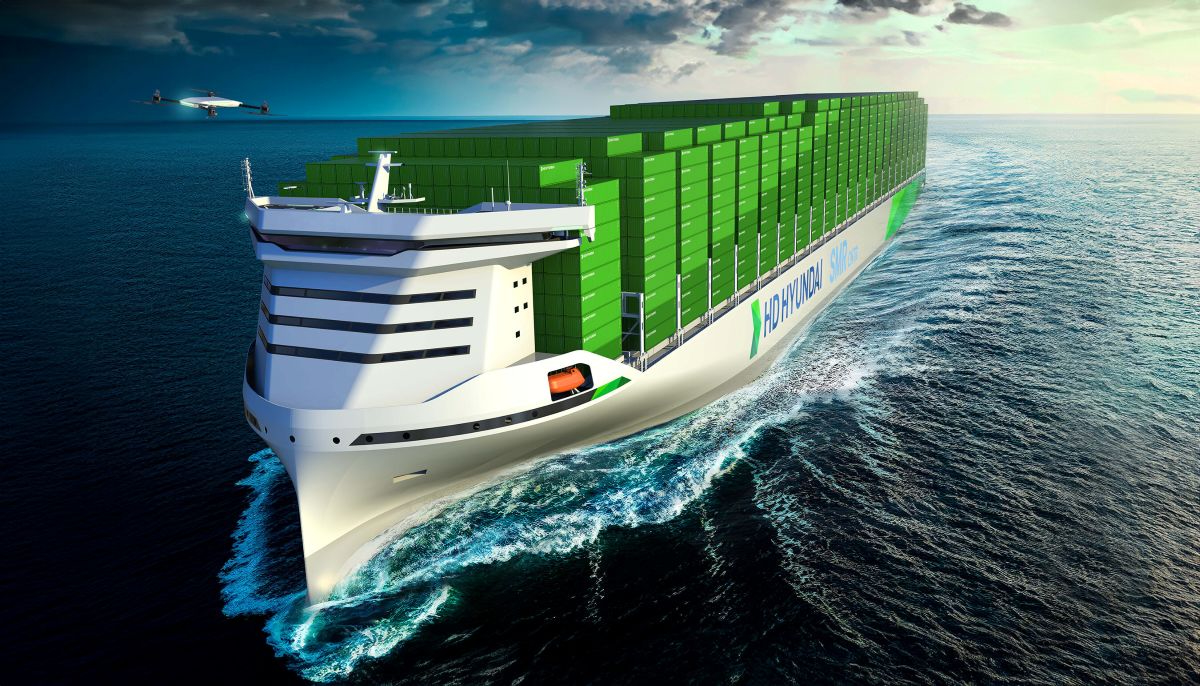Archives
Business, Feature, Freight News, Sea
HD Korea Unveils 15K TEU Nuclear Boxship Design
[ February 28, 2025 // Gary G Burrows ]HD Korea Shipbuilding & Offshore Engineering, or HD-KSAOE, has revealed the design for a 15,000-twenty-foot-equivalent unit nuclear-powered containership that employs modular reactor technology.
The design, which was revealed Feb. 12 at the New Nuclear for Maritime Houston Summit at the Asia Society Texas Center, has received approval in principle from the American Bureau of Shipping, or ABS.
The 15,000-TEU vessel design would use a molten salt reactor propulsion system for heat and a supercritical carbon dioxide (SCO2) system for power generation.
HD KSOE, a subsidiary of HD Hyundai, said the model design features enhanced economic efficiency and safety by incorporating actual equipment and safety design concepts, World Nuclear News reported.
Unlike conventional ships, nuclear-powered vessels do not require engine exhaust systems or fuel tanks. The company has optimized the space previously occupied by large engine room equipment to accommodate additional containers, enhancing economic efficiency. It has also applied a marine radiation shielding system using a double-tank method with stainless steel and light water to ensure safety.
Furthermore, HD KSOE, in collaboration with global energy technology company Baker Hughes, has applied a supercritical carbon dioxide-based propulsion system, improving thermal efficiency by about 5 percent compared with existing steam-based propulsion systems.
“HD KSOE is strengthening cooperation not only with major classification societies but also with international regulatory bodies to establish international regulations necessary for the commercialization of nuclear-powered vessels,” said Park Sangmin, senior vice president of HD KSOE’s Green Energy Research Lab, during a session at the Houston summit. “Starting with the land-based SMR reactor manufacturing project, we aim to develop a marine nuclear business model by 2030.”
Fourth-generation SMRs in the demonstration phase “offer a groundbreaking improvement in safety compared to conventional reactors. When applied to large container ships, they could potentially have less risk than some of the other alternative fuel systems,” Sangmin said, according to a report from Nuclear Engineering International.
In October 2023, ABS approved in principle a design for a floating offshore nuclear power barge from HD KSOE and Kepco Engineering & Construction (Kepco E&C). Project collaborators included ABS, HD KSOE, Kepco E&C and the Liberian International Ship & Corporate Registry. The floating SMR barge is intended to serve as offshore power generation for remote communities and island electrification.
In January 2024, Lloyd’s Register, Zodiac Maritime, HD KSOE and Kepco E&C signed a memorandum of understanding for the development of nuclear-propelled ship designs, including bulk carriers and container ships. Under the joint development project, HD KSOE and Kepco E&C will provide designs for future vessels and reactors while Lloyd’s Register will assess rule requirements for safe operation and regulatory compliance models.
HD KSOE announced plans in February 2024 to develop an SMR for use in shipping in cooperation with the UK’s Core Power, the U.S.’s Southern Co. and TerraPower.
In November 2022, HD Hyundai invested US$30 million in TerraPower. The reactor to be jointly developed centers around TerraPower’s Molten Chloride Fast Reactor (MCFR) design. TerraPower is developing an iteration of the MCFR, known as the m-MSR, intended for marine use.
ABS Requirements for Nuclear Power Systems for Marine and Offshore Applications, published in October 2024, provided the first classification notation for nuclear power service assets such as floating nuclear power plants or nuclear-powered floating production, offloading and storage units.
ABS also released a study, Pathways to a Low Carbon Future LNG Carrier Nuclear Ship Concept Design. investigating the potential of advanced nuclear technology for maritime applications, with a study of SMRs on a standard liquefied natural gas (LNG) carrier. This modeled the impact of a high-temperature, gas-cooled reactor on the design, operation and emissions of a 145,000-cubic-meter LNG carrier.
HD KSOE will continue to collaborate with ABS, the maritime classification society to further develop the vessel. ABS is also working with the U.S. Department of Energy to research barriers to the adoption of advanced nuclear propulsion on commercial vessels, the Nuclear Engineering International report said.
The shipping industry consumes about 350 million tonnes of fossil fuel annually and accounts for about 3 percent of total worldwide carbon emissions. The industry, via the International Maritime Organization, In July 2024 approved new targets for greenhouse gas emission reductions, aiming to reach net-zero emissions by or around 2050.

Tags: HD Korea Shipbuilding & Offshore Engineering







